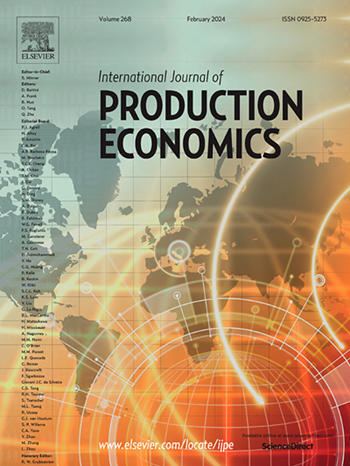Integrating 3D printing and inventory to manage multi-product demand uncertainties
IF 10
1区 工程技术
Q1 ENGINEERING, INDUSTRIAL
引用次数: 0
Abstract
Recently, many firms have rapidly adopted 3D printing technology to better align their supplies with demands and enhance profitability. We examine a firm that sells multiple products and utilizes 3D printing to navigate uncertain demands. Initially, the firm determines product inventories, 3D printing capacity, and raw material investments. Once the demands are realized, they are first met using the existing inventories, with any excess fulfilled through 3D printing. We analyze the optimal policy and profit, comparing the outcomes with and without 3D printing to assess its value. Our findings indicate that 3D printing is advantageous when investment and raw material costs are low. In addition, we explore how various parameters affect this value, identifying two key benefits of 3D printing: cost-saving and flexibility. Given the complexity of determining an exact optimal policy for the general case, we propose a heuristic algorithm to address this challenge. Finally, we investigate the influence of product characteristics, diversity, and supply disruption risks on the value of 3D printing, concluding that its value increases with product diversity and it can effectively mitigate supply risks.
整合3D打印和库存管理多产品需求的不确定性
最近,许多公司迅速采用3D打印技术,以更好地使其供应与需求保持一致,提高盈利能力。我们考察了一家销售多种产品并利用3D打印来导航不确定需求的公司。最初,该公司决定产品库存、3D打印能力和原材料投资。一旦需求实现,他们首先使用现有的库存来满足,任何多余的都通过3D打印来完成。我们分析了最优政策和利润,比较了3D打印和不3D打印的结果,以评估其价值。我们的研究结果表明,当投资和原材料成本较低时,3D打印是有利的。此外,我们探讨了各种参数如何影响此值,确定了3D打印的两个关键优势:节省成本和灵活性。考虑到在一般情况下确定精确的最优策略的复杂性,我们提出了一种启发式算法来解决这一挑战。最后,我们研究了产品特性、多样性和供应中断风险对3D打印价值的影响,得出了产品多样性可以有效降低供应风险的结论。
本文章由计算机程序翻译,如有差异,请以英文原文为准。
求助全文
约1分钟内获得全文
求助全文
来源期刊
CiteScore
21.40
自引率
7.50%
发文量
266
审稿时长
52 days
期刊介绍:
The International Journal of Production Economics focuses on the interface between engineering and management. It covers all aspects of manufacturing and process industries, as well as production in general. The journal is interdisciplinary, considering activities throughout the product life cycle and material flow cycle. It aims to disseminate knowledge for improving industrial practice and strengthening the theoretical base for decision making. The journal serves as a forum for exchanging ideas and presenting new developments in theory and application, combining academic standards with practical value for industrial applications.

 求助内容:
求助内容: 应助结果提醒方式:
应助结果提醒方式:


